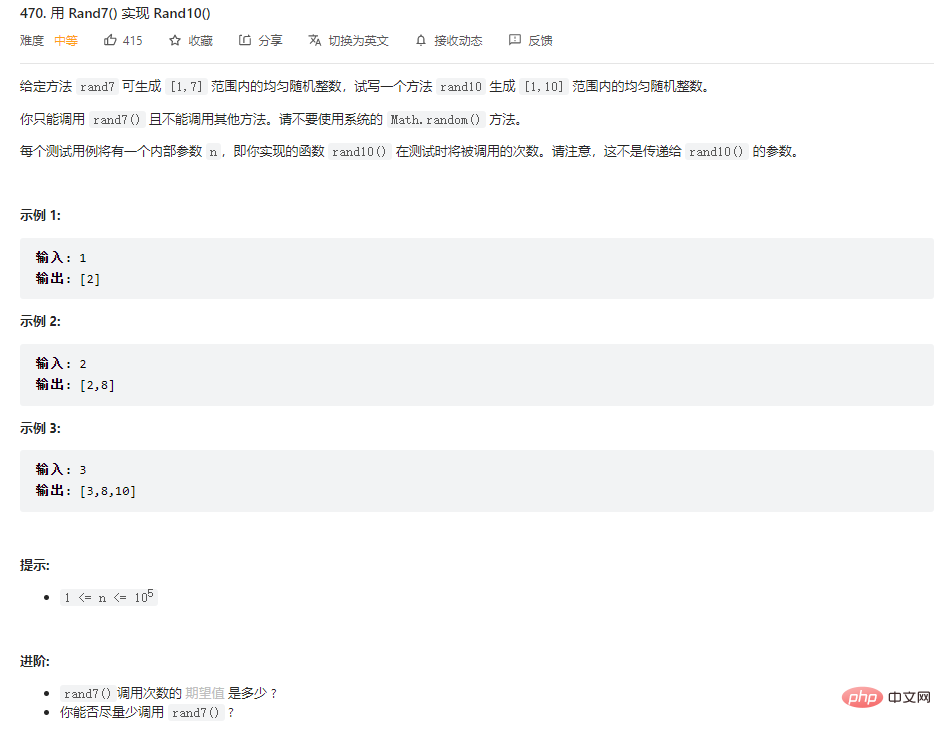ホームページ >Java >&#&チュートリアル >Javaのランダム関数変換例を詳しく解説
Javaのランダム関数変換例を詳しく解説
- WBOYWBOYWBOYWBOYWBOYWBOYWBOYWBOYWBOYWBOYWBOYWBOYWB転載
- 2022-08-24 11:59:021917ブラウズ
この記事では、java に関する関連知識を提供します。主に Java のランダム関数の変換について紹介します。記事内のサンプルコードは詳細に説明されており、Java の学習に役立ちます。興味のある人はさらに詳しく学ぶことができます。

推奨学習: 「Java ビデオ チュートリアル 」
解決済みの問題
質問 1
Java では、Math.random() 関数は、区間 [0,1) 内の任意の小数を等しい確率で返します。つまり、x の場合、<code>[0,x) の数字が出現する確率は x です。 ##x < 1 の場合、[0,x) の数字の確率は x^2 に調整されます。
[0,x) の確率は x であるため、Math.random()# を 2 回呼び出します##、大きい方の値も [0,x) 間隔内にある場合、両方の呼び出しは [0,x) 間隔内にある必要があります (In は、 [x,1)、戻り値は [0,x)) にはなりません。つまり、確率は x^2 です。コードは次のとおりです。 <pre class="brush:java;">package snippet;
public class Code_0004_RandToPow2 {
// 将`[0,x)`中的数出现的的概率调整成`x^2`
public static double randToPow2() {
return Math.max(Math.random(), Math.random());
}
}</pre> 次のテスト コードを通じて質問 1 の解決策を検証できます:
package snippet;
public class Code_0004_RandToPow2 {
// 将`[0,x)`中的数出现的的概率调整成`x^2`
public static double randToPow2() {
return Math.max(Math.random(), Math.random());
}
// 测试用例
public static void main(String[] args) {
int count = 0;
int testTimes = 10000000;
double x = 0.17;
for (int i = 0; i < testTimes; i++) {
if (randToPow2() < x) {
count++;
}
}
System.out.println((double) count / (double) testTimes);
System.out.println(Math.pow(x, 2));
}
}出力された結果は次のとおりです
0.02886030.028900000000000006目標要件に近い。
質問 2
ランダム関数
f() があるとします。この関数は、等しい確率で [1,5] の 1 つを返すことができます。数値、他のランダム関数を導入せずに f() 関数 のみを使用して、[1,7] の任意の数値を返す関数を取得する方法等しい確率 g()。 アイデア
[1,7]
を返すことなので、x() 関数を処理できれば、この関数は、等しい確率で [0,6] の範囲内の任意の数値を返します。その場合、ターゲット関数 g() は、この x()## を呼び出すだけで済みます。 # 関数 1 を追加する、つまり g() 関数では、<pre class="brush:java;">public static int g() {
return x() + 1;
}</pre> が [0,6] を取得し、等しい確率で数値を返す必要があります。 ## 最初に行う必要があります。等しい確率で 0 と 1 を返すランダム関数
を取得するには、f() 関数を通じて取得できます。 , <pre class="brush:java;">// 通过[0,5]等概率返回的随机函数f()
// 加工出等概率得到0和1
// 1,2,3,4,5 五个数
// 得到1,2的时候,返回0
// 得到4,5的时候,返回1
// 得到3的时候,弃而不用,再次尝试
public static int m() {
int ans = 0;
do {
ans = f();
} while (ans == 3);
return ans < 3 ? 0 : 1;
}</pre> はあります。等しい確率で 0 と 1 を返すランダム関数 m() を返す [0,6]
[ 0,6] は表すのに 3 つの 2 進数を必要とするため、m() 関数を 3 回呼び出すことができ、任意の数値を取得できます。 [0,7]の範囲を等しい確率で取得する場合、7を取得したときに上記のプロセスを再試行でき、[0,6]の場合は結果のみが返されます。 #xx() 関数を処理しています。 <pre class="brush:java;"> // 等概率返回0~6
public static int x() {
int ans = 0;
do {
ans = (m() << 2) + (m() << 1) + m();
} while (ans == 7);
return ans;
}</pre>最終的に、目的の関数 f() は次のように取得できます。完全なコードは次のとおりです。 <pre class="brush:java;"> // 等概率返回1~7
public static int g() {
return x() + 1;
}</pre> 質問 3
まずメソッドを実装する必要があります。等しい確率で 0 と 1 を返すランダム関数
m()。
を指定し、ターゲット関数の間隔でバイナリ ビットの数が必要かどうかを確認して、m() 関数を何回呼び出すかを決定します。詳細については説明しません。コード全体については、
関数を何回呼び出すかを決定します。詳細については説明しません。コード全体については、
package snippet;
public class Code_0005_Rand5ToRand7 {
// 此函数只能用,不能修改
// 等概率返回1~5
public static int f() {
return (int) (Math.random() * 5) + 1;
}
// 通过[0,5]等概率返回的随机函数f()
// 加工出等概率得到0和1
// 1,2,3,4,5 五个数
// 得到1,2的时候,返回0
// 得到4,5的时候,返回1
// 得到3的时候,弃而不用,再次尝试
public static int m() {
int ans = 0;
do {
ans = f();
} while (ans == 3);
return ans < 3 ? 0 : 1;
}
// 等概率返回0~6
public static int x() {
int ans = 0;
do {
ans = (m() << 2) + (m() << 1) + m();
} while (ans == 7);
return ans;
}
// 等概率返回1~7
public static int g() {
return x() + 1;
}
}質問 4を参照してください。関数 f() があり、不等確率 (ただし確率は固定) で 0 と 1 を返します。 f() 関数を介してのみ 0 と 1 を返す方法はありますか? ランダム関数
、
アイデア、呼び出し f() 関数を 2 回実行すると、次のような状況が得られます
1 1
0 11 0
は同じである必要がありますので、の確率になります。
0 1
1 0
0 1
Return 0、get1 0完全なコードは次のとおりですReturn 1、つまり
g()## を取得します。 #function
/**
* The rand7() API is already defined in the parent class SolBase.
* public int rand7();
* @return a random integer in the range 1 to 7
*/
class Solution extends SolBase {
public int rand10() {
return rand(10);
}
public int rand(int N) {
int bit = 1;
int base = 2;
while (base <= N) {
base = 2 << bit;
bit++;
}
int v = build(bit);
while (v < 1 || v > N) {
v = build(bit);
}
return v;
}
private int build(int bit) {
int v = 0;
for (int i = 0; i < bit; i++) {
v += (m() << i);
}
return v;
}
// 核心:生成 0 和 1 等概率返回的随机函数
public int m() {
int i = rand7();
while (i == 7) {
i = rand7();
}
return (i == 1 || i == 2 || i == 3) ? 0 : 1;
}
}推奨学習:「 Java ビデオ チュートリアル
以上がJavaのランダム関数変換例を詳しく解説の詳細内容です。詳細については、PHP 中国語 Web サイトの他の関連記事を参照してください。

